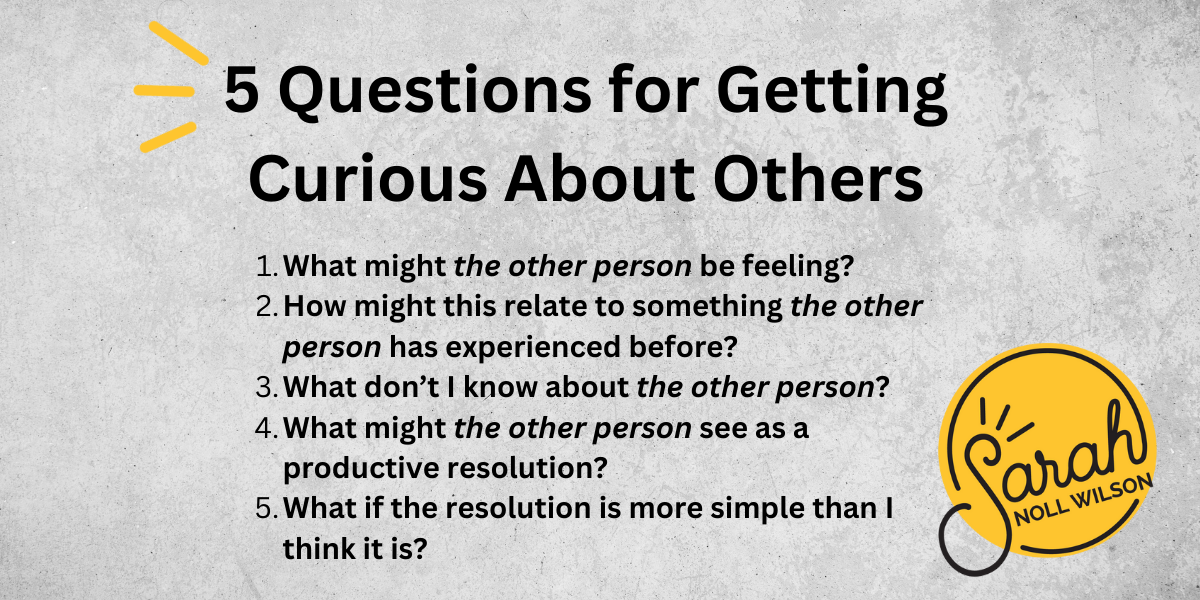
By Dr. Teresa Peterson
Do you ever feel stuck in a loop of overthinking?
Have you ever been so focused on your perspective, problem, or situation that it seemed impossible to get out of your own head?
Have you ever genuinely wanted to resolve a conflict or rebuild a relationship but struggled to create that bridge?
We’ve all been there. When we can self-assess where we’re at with a situation, what our insights are, and where we might have gaps in our thinking, we open ourselves up to so much growth.
In our previous exploration of The Curiosity-First Approach™, we discussed how to get curious with yourself by using 5 Questions to Ask if You Feel Stuck. Now, we’ll explore how getting curious about others moves that needle further toward deeper understanding and relationships, more effective communication and collaboration, and more productive outcomes. That’s why getting curious about others is part two of the Curiosity-First Approach. Let’s look at 5 questions to help get you started:
1. What might the other person be feeling?
Asking this question helps you get outside of yourself instead of staying entrenched in your own experiences and perspectives. That last part—staying entrenched—is a natural response, to be fair. We’re in our heads because we’re in our bodies. Of course we project ourselves onto a situation by nature because our “selves” are what we know best, right? Thinking about what the other person might be feeling takes conscious, intentional effort.
2. How might this relate to something the other person has experienced before?
What might be going on for the other person? What might be at play for them now (or might have come up in the past)? What else is on their plate besides this issue? The list for considering others’ situations goes on and on.
Note that asking these questions does not absolve anyone of wrongdoing or put the onus of forgiveness or resolution squarely on your shoulders. Empathy is a strength, not a weakness. In asking, we aren’t expecting any outward outcome immediately. It’s also not about putting others and their needs over our own. Instead, it’s about asking questions that boost our understanding and inspire us to think differently. We’re trying to simply shift our thoughts to the other person and sit with the possibility that their experience might be different than ours. That’s it!
Watch Out: Considering how the other person might have experienced this (or something like it) before is meant to help expand and boost empathy. Take care not to let stereotypes slip in or somehow let this inner dialogue further cement your own ideas.
3. What don’t I know about the other person?
It’s worth noting that, in getting curious about others, we have to do a little inferring. That’s just how it works. It does not mean that those inferences are going to be correct all the time, and acknowledging that requires us to speak and stand with courage.
One of the most profound things I hear people say in doing this work is, “To be honest, I don’t think I know that person well enough to make an educated guess about what they might be thinking or feeling.”
That perspective is equally important because it can a). become a launchpad for further conversation and b). serve as gut-check guard rails if your inferences start to slip into stereotypes or otherwise become too presumptive.
4. What might the other person see as a productive resolution?
In thinking about what is going on for the other person, you’re also thinking about what they need from the situation, too, to constitute a resolution. This is a small shift with big implications.
Remember that a resolution doesn’t have to be neat and tied up with a bow. It also doesn’t have to be monumental. Sometimes, a resolution is simply to be heard, gain clarity, and cultivate understanding.
5. What if the resolution is more simple than I think it is?
Often, for those of us prone to wheel-spinning, getting curious about others can lead to more wheel-spinning and overcomplication. This isn’t always the case, but it definitely is sometimes. Keeping our feet grounded in the facts of the situation while our head considers what the other person might be feeling is an effective balancing act—go too far in one direction, and you might create a problem when there wasn’t one to begin with.
Sometimes, when I am able to find my entry point into a conversation (often after thinking about some combination of the questions above as well as the 5 Questions to Ask to Get Unstuck) I will discover: “Oh, this person probably just wants XYZ. Maybe it’s not any more complicated than that.”
What’s Next?
The next time you feel the wheels start spinning and you know you need to get out of your own head about a person or a situation, ask yourself these five questions. You might even keep this little graphic around on your desk, in your notebook, or in your car as a reminder.
Let me know if these work for you and what you would add to the list!


Dr. Teresa Peterson
Dr. Teresa Peterson is the Director of Learning and Development for Sarah Noll Wilson, Inc. In her daily work, she serves as Sarah’s key content collaborator. Teresa enjoys facilitating, researching, and is passionate about applying best practices for learning to make our experiences meaningful, engaging, and accessible for all types of learners. Teresa holds a Doctorate in Education from the University of Northern Iowa and brings over twenty years of experience teaching, facilitating, and leading to our team. Our clients love Teresa’s grounded energy, depth of thought, and ability to listen deeply.

